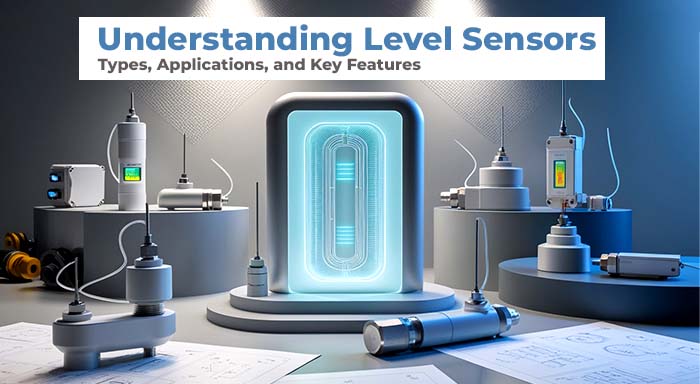Introduction
Level sensors are essential in many industries to give crucial measurements of the materials’ height in containers, tanks, or silos. They can be used for process control to monitor product quality and safety, or for other purposes.
In this blog post, let’s have a look at the various types of level sensors and their uses, and the advantages they add to various processes that occur in the industry.
What are Level Sensors?
Level sensors allow us to determine the level of a liquid, powder, or any granular material. They are available in either point level or switch versions, which identify the presence of a material at a certain level, or level measurement instruments, which constantly inform of the position of a material. The level of selection of the desired sensor depends on the type of material, measurement accuracy, and environmental conditions as well as their costs.
Types of Level Sensors
1. Point Level Sensors
Level-type sensors tell operators when a transported material has reached a certain point, which often is set to give an alarm when the material is about to go beyond or below a certain quantity that is considered optimal. Common types include:
Capacitance Level Sensors:
These IoT sensors reveal the variation in capacitance that is caused by the presence or otherwise of the material in question. They are all round; they are used on liquid, powder, and granules.
Vibrating Fork Sensors:
These kinds of sensors contain a vibrating element and they count on vibrations that occur with material presences to differentiate frequencies. They are particularly suitable for liquids and certain bulk solids; the system provides safe point-level detection.
Optical Level Sensors:
These use infrared light to enable them to determine whether or not there is the existence of liquid. For as long as the light beam is interrupted by the liquid, the sensor triggers an appropriate response. They are perfect for general use in small tanks and vessels.
2. Continuous Level Sensors
Continuous level-IoT sensors provide ongoing data, offering a detailed view of material levels. They are crucial for process automation and inventory management. Types include:
Ultrasonic Level Sensors:
Those that provide the distance from the material surface using a sound wave generator, which emits sound waves that do not come into contact with it. These are suitable for corrosive or dirty materials and are widely applied in water treatment chemicals, and creation sectors.
Radar Level Sensors:
Employing microwave radar signals, these sensors accurately measure levels even under challenging conditions such as high pressure and temperature. They are particularly effective for liquids and solids stored in large tanks.
Magnetostrictive Level Sensors:
These sensors contain a float and a waveguide to give precise level measurements of the liquid. They are accurate when it comes to reading measures of the volume of liquid and mass of solids.
Hydrostatic Level Sensors:
Visited applications of pressure measurement to estimate the level of a liquid by evaluating fluid column force. These are often used in water and wastewater treatment plants.
Also Read
What are Accelerometers? | Technology, Applications, and Advantages
Light Sensors in IoT? | Types, Applications, and Benefits
Applications Of Level Sensors
Level sensor have diverse applications across numerous industries:
Oil and Gas Industry:
Necessary for determining quantities of the solution contained in tanks, monitoring the stocks, and avoiding losses. Microwave and acoustic sensors are especially used for their non-contacting nature as well as for their performance in harsh environments.
Food and Beverage Industry:
The following reasons should be used to promote consistency and quality: thorough observation of the ratios of ingredients in the processing and packaging facilities. Here, capacitance and magnetostrictive sensors are chosen by their hygiene and accuracy.
Water Treatment Plants:
Categorized to take measurements of water depth in reservoirs, and tanks, and for chemical feeding and control to meet regulatory requirements effectively.
Pharmaceutical Manufacturing:
In this particular industry, it is critical to keep certain measurements accurate, and level sensor help maintain the right amounts of liquids and powders for production.
Advantages of using Level Sensors
Implementing level sensors in your processes offers several advantages:
Enhanced Safety:
Used to control overflows and leaks, level sensors minimize accidents, thus increasing safety in a given workplace.
Operational Efficiency:
Real-time enables improvement in inventory control reduction of wastage and control of processes.
Cost Savings:
The elimination of parameters that affect the levels and the exact measurement of these levels allows for savings to be made, which outweighs the cost of monitoring the levels with other devices.
Product Quality Assurance:
Accuracy is important to keep consistent and high quality, always a key factor that satisfies customer’s demand and complies with required standards.
Summing It Up
To sum up, level sensor occupy an essential place in contemporary industrial processes supplying the necessary information about productivity, safety, and quality of the processes. If you select the right type of sensor for your application, then you can enhance the processes and yield better results.
level sensors - Frequently Asked Questions (FAQs)
What are the main types of level sensors?
The main types of level sensors include point-level sensors, such as capacitance and vibrating fork sensors, and continuous-level sensors, including ultrasonic, radar, and magnetostrictive sensors.
How do ultrasonic-level sensors operate?
Ultrasonic level sensors use sound waves to determine the distance between the sensor and the material surface. The sensor emits a sound wave, which reflects off the surface, and the time taken for the echo to return is used to calculate the level.
What factors should be considered when selecting a level sensor?
When choosing a level sensor, consider the type of material, environmental conditions, required accuracy, measurement range, and budget. Additionally, consider the sensor's compatibility with existing systems and its maintenance needs.
Can level sensors be used in hazardous environments?
Yes, many level sensors, such as radar and ultrasonic sensors, are designed for noncontact measurements, making them suitable for hazardous environments with extreme temperatures, pressures, or corrosive materials.
How do hydrostatic level sensors work?
Hydrostatic level sensor measure the pressure exerted by a liquid column to determine the level. They are commonly used in applications involving water and wastewater, providing reliable and accurate measurements.
Related Reads
Humidity Sensors In IoT? Know the Types, Applications, and Benefits
Understanding Temperature Sensors | Types, Applications, and Benefits



